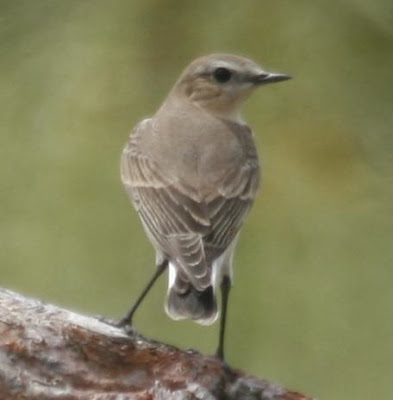Northern Wheatear, a New Species for Panama

On the morning of October 23, visiting birder Tom Hince found a female Northern Wheatear near the Las Olas resort in Playa La Barqueta, near David Chiriquí.
When you leave Los Olas resort heading north on the paved road you go about 2 km and the paved road makes an abrupt right turn in a small hamlet. Instead of following the paved road, turn north (which is straight ahead if leaving Los Olas and heading north). This road is gravel. After leaving the small hamlet and continuing north on the gravel road you come into an area of grassland. The bird was on the left side of the road about a half a km north on the gravel. It was on the fenceline but dropped into the field out of sight.
This is the first record of Northern Wheatear, a bird that breeds in the rocky tundra of extreme north Canada and Alaska and winters in Africa. There are records from Yucatán and the Caribbean, but this is the first record this far south in the Americas, and the first for the Pacific slope of the continent south of California.
Panama Records Committee member Dodge Engleman chimes in:
Panama Records Committee member Dodge Engleman chimes in:
There are 21 spp of Wheatear and only one is known to occur in the New World, and only as a vagrant south of Canada. That makes one suspect it was ship assisted, but it's hard to think of a ship docking in David that came from somewhere the species occurs!Tom adds,
It looks like a breeding plumaged female, and they usually molt into non-breeding plumage in September. Her feathers are "worn" though so maybe she's just molting late.
I have some experience with this bird in Ontario, having found a couple there. I reiterate my initial thoughts. I think this record fits well within the expected pattern of vagrancy for this species. The majority of Arctic breeding wheatears migrate southeast to Europe, but clearly a small percentage do not. The timing is perfect for a fall migrant (which is when a vagrant would probably be expected). In my experience, vagrant wheatears seem to appear in open field habitat throughout all of eastern North America (and apparently parts of central America and the Caribbean) - and the habitat which this bird was in fits this well. They are exceptionally strong fliers (eastern Canadian Arctic breeders regularly fly not stop to western Europe). This individual was 3 km from the coast in open field habitat, and nowhere near a port. While I agree that it is important to consider all options, I feel pretty comfortable in thinking this is a genuine vagrant.